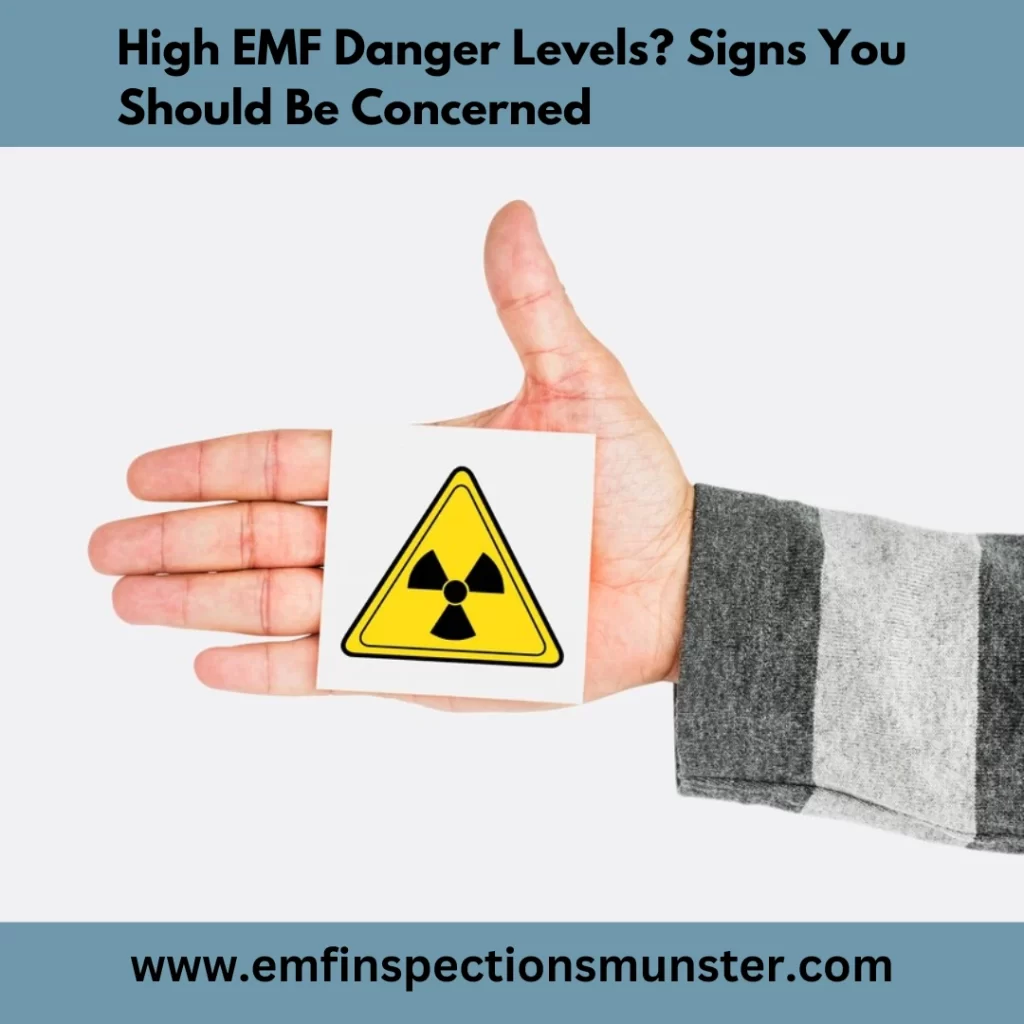In today’s technology-driven world, electromagnetic fields (EMFs) are everywhere. From mobile phones and Wi-Fi routers to household appliances and power lines, these invisible energy fields have become an unavoidable part of modern life. While EMFs are generally considered safe at low levels, prolonged exposure to high EMF danger levels has raised concerns among health professionals and researchers.
This article explores the signs that indicate potential EMF-related health risks, the possible long-term effects of exposure, and practical steps you can take to mitigate its impact.
Understanding EMFs and Their Sources
Electromagnetic fields (EMFs) are regions of energy generated by objects with electric charges. They are divided into two primary categories:
Natural EMFs:
These originate from sources such as the Earth’s magnetic field and thunderstorms. Natural EMFs are typically low and do not pose significant health risks.
Artificial EMFs:
Generated by human-made sources, artificial EMFs are far more intense and prevalent in modern environments. A few of the most frequent origins consist of:
- Mobile phones and wireless devices
- Wi-Fi routers
- Power lines
- Household appliances (microwaves, refrigerators, televisions)
- Bluetooth devices
- Smart meters
- 5G networks
Types of EMFs Based on Frequency:
- Low-Frequency EMFs: Produced by household electrical appliances and power lines.
- High-Frequency EMFs: Emitted by cell phones, Wi-Fi networks, and X-ray machines.
Recognizing High EMF Danger Levels
While different organizations have set varying exposure limits, the International Commission on Non-Ionizing Radiation Protection (ICNIRP) provides guidelines to ensure public safety. For instance, ICNIRP recommends a limit of 100 microteslas (µT) for power frequency fields for the general public. However, some studies suggest that long-term exposure to levels as low as 0.4 µT may increase the risk of childhood leukemia.
Assessing whether your surroundings have high EMF danger levels requires specialized EMF meters. These devices can measure electromagnetic radiation emitted from different sources and help determine if exposure levels are within a safe range.
Symptoms of High EMF Exposure
Although scientific consensus on EMF health risks remains divided, many individuals report experiencing various symptoms when exposed to high levels of EMFs. This condition, often referred to as Electromagnetic Hypersensitivity (EHS), includes the following symptoms:
- Chronic fatigue
- Frequent headaches
- Dizziness or nausea
- Sleep disturbances (insomnia, restlessness)
- Skin tingling or burning sensations
- Brain fog and memory problems
- Increased anxiety and irritability
- Muscle and joint pain
- Heart palpitations
While medical research has yet to confirm a direct link between EMFs and these symptoms, anecdotal evidence suggests that reducing EMF exposure alleviates discomfort for some individuals.
Potential Health Risks of Prolonged EMF Exposure
The potential long-term effects of prolonged exposure to high EMF levels remain an area of active research. Some studies suggest that excessive EMF exposure may be linked to the following health conditions:
1. Increased Risk of Cancer
The International Agency for Research on Cancer (IARC) has classified radiofrequency EMFs as “possibly carcinogenic to humans.” Some studies have suggested a possible association between prolonged EMF exposure and certain types of brain tumors, such as gliomas and acoustic neuromas.
2. Neurological Disorders
Research indicates that EMFs can influence neural activity, leading to cognitive impairment, stress-related disorders, and potential neurodegenerative diseases such as Alzheimer’s and Parkinson’s disease.
3. Sleep Disruptions
Exposure to EMFs, particularly at night, has been shown to interfere with melatonin production, the hormone responsible for regulating sleep cycles. Insufficient melatonin levels may result in persistent insomnia and exhaustion.
4. Reproductive Issues
Several studies suggest that prolonged exposure to high EMFs may negatively impact fertility. Research has shown that sperm motility and viability can be affected by excessive exposure to mobile phone radiation.
5. Increased Oxidative Stress
Oxidative stress is a condition where free radicals in the body outnumber antioxidants, leading to cellular damage. Some studies suggest that EMFs contribute to increased oxidative stress, potentially leading to inflammation, accelerated aging, and a higher risk of chronic diseases.
How to Reduce EMF Exposure?
While it is impossible to eliminate EMFs entirely, you can take practical steps to reduce exposure and mitigate potential health risks:
1. Minimize Device Usage
- Limit mobile phone usage and use speakerphones or wired headsets instead of holding the phone close to your head.
- Avoid using wireless devices for extended periods.
- Disable Wi-Fi and Bluetooth when they aren’t in use.
2. Maintain a Safe Distance
- Keep a safe distance from EMF-emitting devices such as routers, TVs, and microwaves.
- Avoid sleeping with your phone near your bed.
- Position furniture away from power outlets and electrical wiring.
3. Shield Your Living Space
- Use EMF shielding materials such as anti-radiation phone cases, EMF-blocking paint, and Faraday fabric curtains.
- Choose wired internet connections rather than Wi-Fi to minimize electromagnetic radiation.
4. Grounding Techniques
- Walk barefoot on natural surfaces like grass or soil to help balance electrical charges in your body.
- Consider using grounding mats or bed sheets designed to reduce EMF exposure.
5. Limit Exposure to Smart Devices
- Reduce usage of smart home devices that emit constant wireless radiation.
- Turn off smart meters if possible and use analog alternatives.
6. Invest in EMF Protection Devices
- Use EMF meters to measure radiation levels at home and work.
- Consider EMF-neutralizing devices designed to harmonize electromagnetic radiation.
Final Thoughts
With the increasing presence of technology in our daily lives, EMF exposure is inevitable. However, being aware of high EMF danger levels and taking proactive measures to reduce exposure can help mitigate potential health risks. While more research is needed to establish conclusive links between EMFs and specific health conditions, prioritizing safety by limiting exposure and adopting protective measures is a wise approach.
If you suspect high EMF exposure in your environment, consider consulting an EMF specialist near me to conduct professional assessments and provide expert recommendations tailored to your situation.
Frequently Asked Questions:-
1. What are the typical origins of EMF exposure in everyday life?
- EMFs come from various sources, including mobile phones, Wi-Fi routers, power lines, household appliances (microwaves, televisions, refrigerators), Bluetooth devices, smart meters, and 5G networks.
2. What symptoms might indicate high EMF exposure?
- Some individuals report symptoms like chronic fatigue, headaches, dizziness, sleep disturbances, brain fog, skin tingling, anxiety, and heart palpitations when exposed to high EMF levels.
3. Can prolonged EMF exposure lead to serious health issues?
- Research suggests that prolonged exposure to high EMF levels may be linked to cancer risk, neurological disorders, sleep disruption, reproductive issues, and increased oxidative stress. However, more studies are needed for conclusive evidence.
4. What steps can I take to minimize my EMF exposure in my home?
- You can reduce EMF exposure by limiting mobile phone usage, turning off Wi-Fi when not in use, maintaining a safe distance from EMF-emitting devices, using shielding materials, and opting for wired connections instead of wireless.
5. Should I get my home tested for EMF radiation?
- If you are concerned about high EMF levels, using an EMF meter or consulting an EMF specialist can help assess radiation levels and provide recommendations to minimize exposure.


